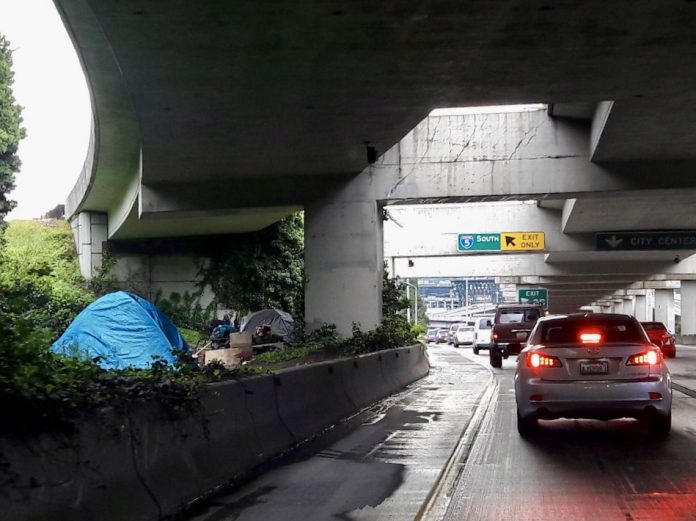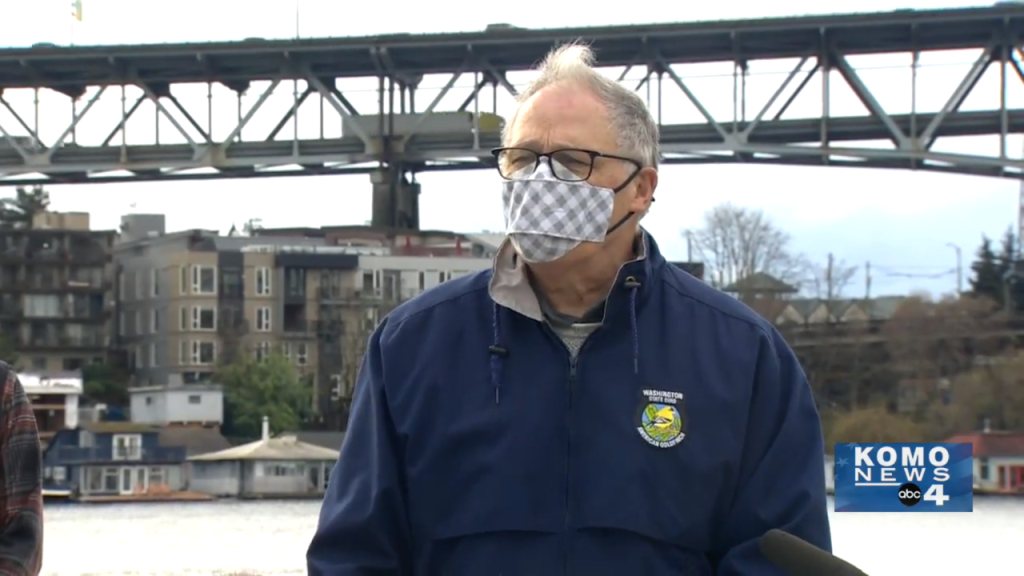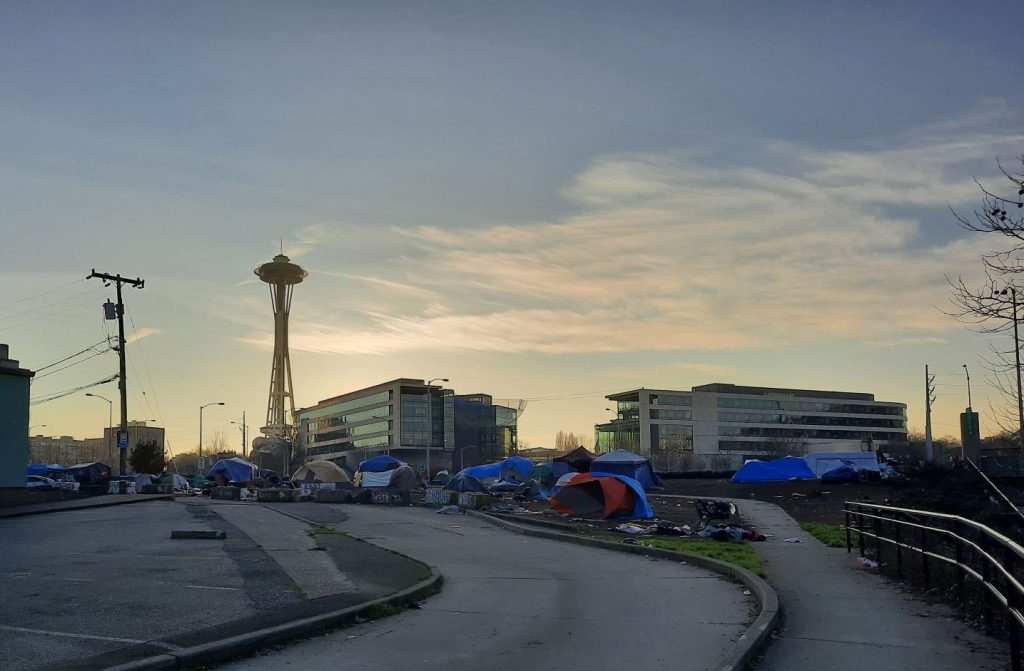
Encampments along roadways are among the most visible signs of the homelessness crisis in Washington State. But does that mean that these encampments should be prioritized for outreach, services, and, eventually, removal? For Governor Jay Inslee and a cadre of prominent lawmakers and local leaders, the answer is yes, which is why they are pushing for the legislature to pass Senate Bill 5662, which seeks to do just that, this legislative session.
Inslee described the bill as a “tremendous opportunity this year the legislature has to coordinate our response to homelessness, particularly in our rights-of-way — our highways, freeways, and byways.”
Some advocates for homeless people have disagreed — fearing the bill, which includes stated the goal of reducing the number of people living in unsanctioned encampments on public rights-of-way, would result in an increase in harmful and counterproductive sweeps while not significantly reducing the number of people living unsheltered in the state. Inslee, however, remains steadfast in his support for the bill.
“We really need to give an adequate priority to those people who are encamped along our highways and rights-of-way. The public is demanding this and we have a bill that acknowledges all of these concerns and gets at solutions in months rather than years,” said Inslee during an hour-long press conference last week devoted to the issue in which he was joined by elected leaders from Seattle, Tacoma, and Spokane.
Inslee’s estimate of the situation was echoed by Seattle Mayor Bruce Harrell. “Many of my constituents in Seattle want rapid fixes, rapid solutions, but we all realize that a lot of these issues of homelessness and public safety have been decades in the making, not just in Seattle or the state of Washington, but throughout our country… I think it going to take this level of collaboration to truly move the needle and I welcome it,” Harrell said.
Reservations about highway encampment removal bill
While SB 5662 has earned praise from some elected leaders, the bill has also stoked controversy along the way. Inslee has described the bill as providing a means by which the state can act “quickly and compassionately” to get people experiencing homelessness into housing, but some homeless advocates and service providers including representative from Real Change, ACLU Washington, Washington Low Income Housing Alliance, and the King County Coalition on Homelessness have all expressed concerns about the proposed legislation.
“We too agree that the housing crisis demands urgent action. However, until there is sufficient adequate alternative placements for Washington residents experiencing housing instability to go, coordinating around reducing the visibility of homelessness will never decrease the number of people living outside,” said Breanne Schuster, staff attorney for ACLU Washington, during a public hearing on the bill.
According to the text of SB 5662, more than 1,750 unsanctioned encampments currently exist on public rights-of-way managed by state agencies, a situation Inslee has described as “sad reality” that “affects every part of our state.” The State does not have enough shelter space and supportive housing units for the entirety of the state’s homeless population, which bolsters Schuster’s case that the State and its partners may find themselves unable to offer viable alternatives for the homeless people they’re removing from state property.
As the homelessness crisis worsened in Washington State, and emergency shelter space grew rare as a result of restrictions necessitated by the Covid pandemic, the number of encampments on Washington State Department of Transportation (WSDOT) land spiked in size and prevalence. The reason for the increase can be traced back to the fact that WSDOT right-of way remains one of the few areas of a jurisdiction in which it is possible to build an encampment, in part because the land often is separate from private property, but also because it is more difficult for jurisdictions to remove encampment in these areas than on city property. Being farther from residential neighborhoods also may help campers avoid conflict with their stably housed neighbors, who pressure the city to remove them.
While some have questioned if the state has made it unnecessarily difficult to access encampments on WSDOT land, Harrell described the process by which a city must follow to take action on state-owned property as “not necessarily burdensome, just a little clunky.” Still providing services, completing maintenance, and engaging in encampment removal on these lands does require more involved planning and collaboration among public partners than on city property.

When explaining why to prioritize encampment removal on WSDOT land, Inslee emphasized the state’s responsibility for maintaining its property as a public good. “I understand that service providers and local leaders can face seemingly unending challenges around prioritizing who they should reach out to and how to best help them,” Inslee said. “But we in state government have a stewardship responsibility for our rights-of-way and moral obligation to those living in squalor along our rights-of-way.”
Inslee describes the issue as impacting all areas of the state, but it is clear that some jurisdictions have been more heavily impacted than others. One-fifth of the City of Fife’s land is falls under the category of public right-of-way, a product of the city’s proximity to I-5, the Port of Tacoma, and the massive Puget Sound Gateway highway expansion program. Officials estimate that about 500 individuals are living in encampments in public rights-of-way in Fife, according to public testimony from Doug Levy, a lobbyist advocating in support of SB 5662 on behalf of the city. Fife officials have stated that the magnitude of the problem goes beyond what the small city can address, necessitating state assistance.
Olympia is another city that has described difficulty in coordinating with the state around responding to homelessness encampments on rights-of-way. The city recently entered into an interlocal agreement to “address encampments for clean-up purposes” but would need funding and the intergovernmental office that would be created by the bill to support their efforts.
What to know about SB 5662
The proposed bill would create an intergovernmental office within the state’s Department of Social and Health Service (DHS) tasked with reducing the number of people camping on certain public roads and highways by transitioning them to emergency and permanent housing. It would also bring $815 million in funding to pay for housing, services, and programs for people experiencing homelessness and establish a performance monitoring system to track data on outcomes for people served by the programs and services funded by the bill. Progressive lawmakers, such as Sen. Joe Nguyen (D-West Seattle), a member of the body’s progressive wing and co-sponsor of the bill, support the legislation because of the funding it brings to services, programs, and housing.
But while supporters have referenced the funding attached to the bill, some detractors have argued that $815 million in funding is not sufficient to address the issue, drawing attention to the fact that the bill’s fiscal note judges that it will have no impact on the capital budget.
SB 5662 was spurred by an omnibus transportation appropriations act passed in the previous legislative session focused on the issue of encampments on state-owned roadway, as well as additional transportation provisos passed by the legislature requiring the government address safety and public health problems on WSDOT-owned land in Seattle and Tacoma.
The bill includes a reference to a data-tracking requirement that would oblige jurisdiction to collect and share information related to their outreach to people encamped on public rights-of-way and the outcomes for these individuals, i.e., whether they entered into emergency shelter, housing, or remained unsheltered.
An amendment added to the bill would terminate the Office of Intergovernmental Coordination on Public Right-of-Way Homeless encampments July 1st of 2027.
Encampment sweeps remain polarizing
When met with the criticism that SB 5662 would result in increased sweeps, some lawmakers have gone on the defensive.
“Let me be clear, governor, and I tend to be transparent and honest, that I do not support sweeps and I do not believe this is anywhere near a sweeps bill. This is about a statewide coordinated support bill to get people into housing,” said Victoria Woodards, Mayor of Tacoma.
Woodards went on to reference an encampment removal underway in Tacoma near I-705, which she called a “heartbreaking example.”
“The unfortunate reality is that cities across the state are having to remove encampments to address impacts to health and safety… I wish that we had the resources today proposed in Senate Bill 5662, and could offer them increased access to rapid housing and wrap-around services,” Woodards said.
Woodards sentiments were shared by Seattle City Council President Debora Juarez. “Encampment sweeps don’t work. We know that. We do know and we knew that before the 9th Circuit Court ruling in the Boise case. What does work is the basic understanding that this is a statewide crisis,” Juarez said.

The text of SB 5662 attempts to tread a careful line between encouraging the removal of encampments in the public rights-of-way while not violating the federal rights enshrined by last year’s federal court ruling Martin v. Boise, which upheld that sweeping people experiencing homelessness without offering them shelter was “cruel and unusual punishment” and thus not permitted under law.
SB 5662 goes into detail around the requirements that must be met in order for an encampment removal to take place. The bill states that prior to encampment removal regional outreach team much “support and engage with person encamped on public rights-of-way” and that this engagement “must be consistent with and support local homeless and housing plan efforts to result in transitioning persons encamped on public rights-of-way to permanent housing solutions.”
But before it goes to provide more details on the need for the shelter or housing to be offered prior to encampment removal, in order to comply with Martin v. Boise, a significant exception appears. These efforts are required “[e]xcept for emergencies concerning public health and safety, worker safety and access, and public access.”
In the estimation of Schuster of ACLU Washington, this clause essentially nullifies any requirement the local and state entities have to provide access to shelter because all encampments in public rights-of-way are defined earlier in the bill as safety and public health risks.
Being homeless in any public right-of-way presents health and safety risks. Public right-of-way encampments present increasing concerns for the health and safety of those encamped in this space, the public, and those workers who are responsible to maintain and improve public lands.
Washington, SB 5662, 2022
But whether “risk” and “emergency” would be defined interchangeably in a legal context remains to be seen. Schuster, who signed in as “other” during the public hearing rather than pro or con in regards to the bill, described numerous possible violations of people’s rights that could result from the bill’s passage in its current form during her public testimony. However, she also asserted that amendments could be enacted that would be provide greater clarity and ensure people’s civil rights are upheld.
SB 5662 advances forward
Less than a week after Inslee’s press conference and the bill’s public hearing, a second substitute version of the bill was passed out of committee. It will next be read by the Senate Rules Committee, which will decide whether or not the bill will proceed for full consideration on the Senate floor. So far the changes to the bill have been relatively minor and most opposition from lawmakers has come from the Republican side of the aisle. Some advocates, like Melanie Smith of the King County Homelessness Coalition, have pressed for an amendment to be added to the bill that specifying that it would only prioritize “individuals living the most dangerous situations” such as active construction sites, but it remains to be seen if lawmakers will be onboard for such a narrowing of its scope.
While some have questioned if providing to resources to some encampments may provide an interim solution as more emergency shelter and affordable housing is brought online, Inslee has rejected the suggestion. “I just think that’s a terrible idea. A tent next to an express lane is not an acceptable solution,” Inslee said.
While framing himself as the protector of homeless campers rather than the landlord plotting their eviction, the issue is not as black and white as the governor suggests. Not all of the approximately 1,750 unsanctioned encampments on WSDOT land spill onto freeway lanes or medians like he described. For example, one of the largest encampments, dubbed “The Jungle,” was underneath an elevated section of I-5 and adjoining greenbelt along Beacon Hill. Passing motorists could hardly tell it was there underneath them. Following a fatal shooting in 2016, the City cleared the encampment and WSDOT installed extensive razor-wire fencing at a cost of $1 million to prevent homeless people from resettling underneath the freeway.
With not enough deeply affordable housing to go around, displaced campers moved to form encampments in other locations around the city, including a large encampment just to the north at the giant interchange of I-90 and I-5, which local media christened “The New Jungle” or “The Triangle.” Critics pressured the city to sweep “The New Jungle” in January 2020, due to reports of gunfire and drug dealing. And so the cycle continued.
It’s not clear if this new legislation represent a true break from the cyclical whack-a-mole efforts of the past or just a doubling down.
Natalie Bicknell Argerious (she/her) is a reporter and podcast host at The Urbanist. She previously served as managing editor. A passionate urban explorer since childhood, she loves learning how to make cities more inclusive, vibrant, and environmentally resilient. You can often find her wandering around Seattle's Central District and Capitol Hill with her dogs and cat. Email her at natalie [at] theurbanist [dot] org.


